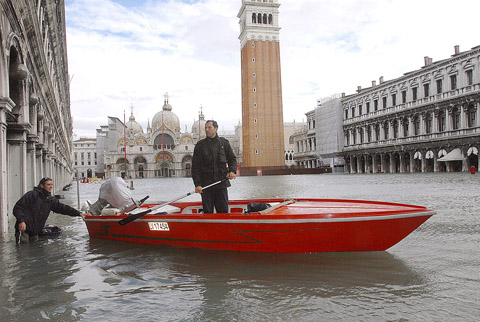Venice could use a bailout. The city built on water has too much of it.
Residents and tourists waded through knee-deep water on Monday as they navigated the city’s narrow streets and alleys and its historic St. Mark’s Square was inundated. Boxes of tourist merchandise floated inside the flooded shops around the square and even the city’s famed pigeons sought refuge on rooftops and windowsills.
One of the highest tides in its history brought Venice to a virtual halt, rekindling a debate over a plan to build moveable flood barriers in an effort to save the lagoon city from high tides.

PHOTO: AP
City officials said the tide peaked at 156cm, well past the 110cm flood mark, as strong winds pushed the sea into the city.
Alarms went off at 6:37am to alert citizens, but many residents were taken by surprise because authorities had initially not forecast such a high water level.
In St. Mark’s Square, one of the city’s lowest points, tourists tried to stay dry by hopping on cafe tables and chairs sticking out of the water. The water was so high that someone rowed a small speedboat across the wide square.
“It was quite an extraordinary experience,” said Michel Gorski, visiting from Brussels with his wife. “We got stuck in the hotel for half a day but we didn’t suffer. We were sorry for the restaurants and stores around, but there was no panic and everyone worked really hard to clean up quickly.”
Workers were unable to install the traditional raised wooden walkways used during flooding because the water rose so high the platforms would have floated away too.
It was the fourth-highest tide since 1872, when the city started keeping records. The last time Venice saw such high waters was in 1986, while the all-time record was 194cm in 1966.
That flood forced 3,000 people to evacuate and damaged many historic buildings, but largely spared the city’s art — which had long ago been removed to upper floors because of flooding by tides.
Giancarlo Galan, the conservative governor of the surrounding Veneto region, criticized Venice’s center-left administration for failing to prepare for the flood and for allegedly stonewalling a long-planned system of barriers that would rise from the seabed to ease the effect of high tides.
The US$5.5 billion project, called “Moses” after the Biblical figure who parted the Red Sea, has been under construction for years and is expected to be completed by 2011. The company building the barriers said that had the system been in place, the city would not have been flooded on Monday.

Kehinde Sanni spends his days smoothing out dents and repainting scratched bumpers in a modest autobody shop in Lagos. He has never left Nigeria, yet he speaks glowingly of Burkina Faso military leader Ibrahim Traore. “Nigeria needs someone like Ibrahim Traore of Burkina Faso. He is doing well for his country,” Sanni said. His admiration is shaped by a steady stream of viral videos, memes and social media posts — many misleading or outright false — portraying Traore as a fearless reformer who defied Western powers and reclaimed his country’s dignity. The Burkinabe strongman swept into power following a coup in September 2022

‘FRAGMENTING’: British politics have for a long time been dominated by the Labor Party and the Tories, but polls suggest that Reform now poses a significant challenge Hard-right upstarts Reform UK snatched a parliamentary seat from British Prime Minister Keir Starmer’s Labor Party yesterday in local elections that dealt a blow to the UK’s two establishment parties. Reform, led by anti-immigrant firebrand Nigel Farage, won the by-election in Runcorn and Helsby in northwest England by just six votes, as it picked up gains in other localities, including one mayoralty. The group’s strong showing continues momentum it built up at last year’s general election and appears to confirm a trend that the UK is entering an era of multi-party politics. “For the movement, for the party it’s a very, very big

ENTERTAINMENT: Rio officials have a history of organizing massive concerts on Copacabana Beach, with Madonna’s show drawing about 1.6 million fans last year Lady Gaga on Saturday night gave a free concert in front of 2 million fans who poured onto Copacabana Beach in Rio de Janeiro for the biggest show of her career. “Tonight, we’re making history... Thank you for making history with me,” Lady Gaga told a screaming crowd. The Mother Monster, as she is known, started the show at about 10:10pm local time with her 2011 song Bloody Mary. Cries of joy rose from the tightly packed fans who sang and danced shoulder-to-shoulder on the vast stretch of sand. Concert organizers said 2.1 million people attended the show. Lady Gaga

SUPPORT: The Australian prime minister promised to back Kyiv against Russia’s invasion, saying: ‘That’s my government’s position. It was yesterday. It still is’ Left-leaning Australian Prime Minister Anthony Albanese yesterday basked in his landslide election win, promising a “disciplined, orderly” government to confront cost-of-living pain and tariff turmoil. People clapped as the 62-year-old and his fiancee, Jodie Haydon, who visited his old inner Sydney haunt, Cafe Italia, surrounded by a crowd of jostling photographers and journalists. Albanese’s Labor Party is on course to win at least 83 seats in the 150-member parliament, partial results showed. Opposition leader Peter Dutton’s conservative Liberal-National coalition had just 38 seats, and other parties 12. Another 17 seats were still in doubt. “We will be a disciplined, orderly